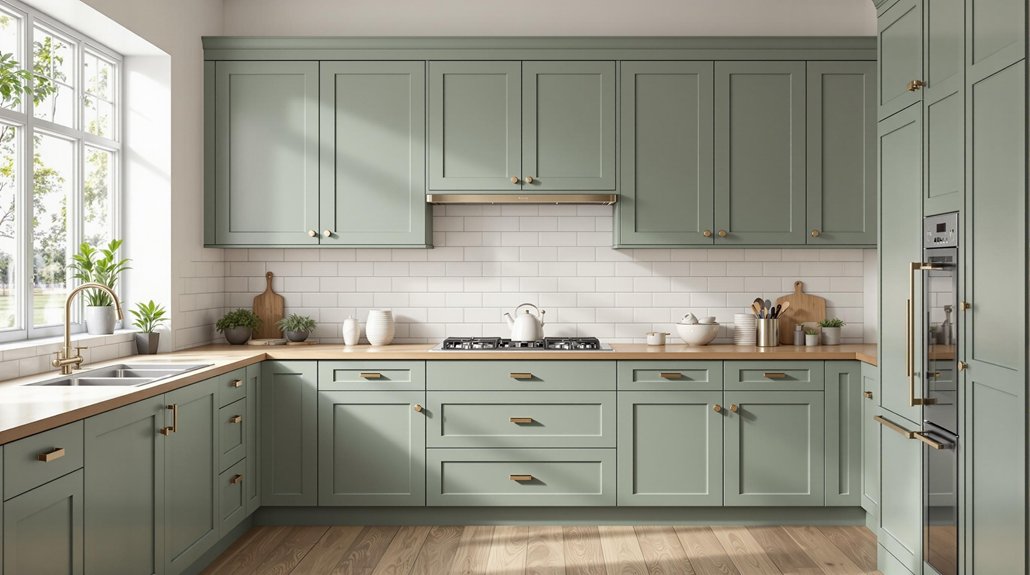
20 Sage Kitchen Cabinet Ideas That Are Stylish and Timeless
Sage kitchen cabinets introduce harmony and timeless character through expert color pairing, material layering, and strategic accents. Incorporating wooden countertops, gold or black hardware, and crisp white or greige tones accentuates the natural beauty of sage, balancing warmth and tranquility. Design options include painting kitchen islands, tiling walls, and integrating statement fixtures for visual depth. With approaches ranging from modern sophistication to classic cottage flair, further ideas showcase sage’s adaptability and enduring design impact.
Key Takeaways
- Paint the kitchen island sage green to create a refined focal point that adds depth and tranquility to any kitchen style.
- Pair sage green cabinetry with natural wood or butcher block countertops for warmth, texture, and timeless rustic sophistication.
- Accent sage cabinets with gold or black hardware to introduce elegant contrast and sophisticated, modern touches.
- Combine sage green cabinets with crisp white or greige elements for a bright, balanced, and versatile kitchen palette.
- Use light sage cabinetry for a cottage-inspired atmosphere, complemented by vintage fixtures and nature-inspired décor for enduring charm.
Paint the Kitchen Island in Sage
When incorporated thoughtfully, painting the kitchen island in sage green establishes a visual anchor that introduces both depth and cohesion to the overall design scheme. A sage green island, rendered in a soft green paint, serves as a refined focal point that seamlessly integrates with contemporary and traditional kitchens alike. The subtle undertones of sage green harmonize with natural wood countertops, enhancing warmth and articulating a rustic yet sophisticated ambiance. This palette selection supports an inviting kitchen environment by promoting openness and a connection to nature, infusing tranquility and balance. Strategically, a light sage green also offers versatility, enabling effortless seasonal shifts through accessories and textiles. The result is a timeless, adaptable feature that complements cabinetry while amplifying the kitchen’s inherent character and visual interest. Incorporating eco-friendly materials in your kitchen design can further enhance the sustainability and aesthetic appeal of your space.
Embrace Completely Sage Walls
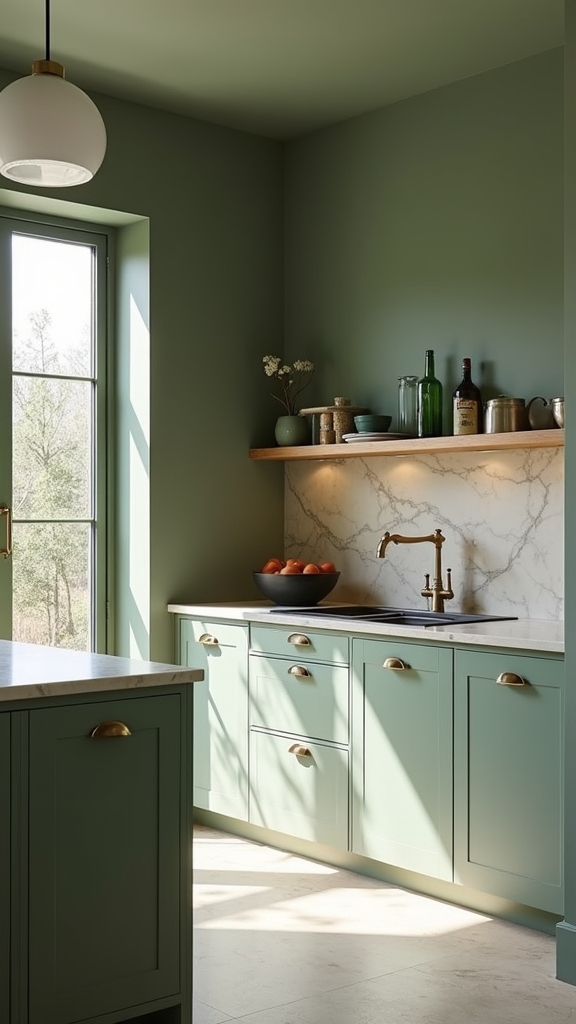
Opting for completely sage walls establishes a unified and serene kitchen backdrop, promoting spatial harmony and visual calm.
Incorporating shiplap or textured wall treatments in this hue introduces subtle depth while preserving an understated elegance.
This combination supports versatile styling options and accentuates architectural interest within the space.
Unified, Serene Kitchen Backdrop
A unified sage backdrop establishes a calm, visually cohesive foundation that enhances the kitchen’s sense of space and serenity.
When sage green walls envelop the entire kitchen, they create a seamless flow, eliminating visual boundaries between cabinetry and surfaces. This unified backdrop amplifies the calming atmosphere, making the environment feel tranquil and uncluttered.
Sage green’s muted undertone responds well to natural light, brightening the kitchen while maintaining a soft, soothing effect. Designers favor this approach for its ability to serve as a neutral canvas; the sage green walls accommodate evolving decor styles and seasonal accents with ease.
The timeless appeal of sage guarantees enduring relevance, offering homeowners a sophisticated backdrop that resists fleeting trends while supporting long-term design flexibility and visual harmony.
Shiplap Walls Enhance Texture
Elevating visual depth, shiplap walls painted in sage introduce tactile dimension and refined texture to the kitchen environment. This design approach establishes a cohesive, unified backdrop that instantly amplifies visual interest while fostering a cozy atmosphere reminiscent of farmhouse aesthetics.
The soft sage hue, when applied to shiplap, diffuses natural light, brightening the space and promoting a serene, inviting ambiance. Shiplap walls offer remarkable versatility, coordinating seamlessly with diverse cabinetry styles, countertop materials, and fixture finishes to guarantee lasting, timeless appeal.
As a strategic design element, sage shiplap not only enhances architectural character but also provides an elegant canvas for curated decorative accents. The result is a kitchen that balances sophistication and warmth, merging functionality with enduring visual charm.
Pair Sage Cabinets With Wooden Countertops
Pairing sage kitchen cabinets with wooden countertops introduces a harmonious interplay between soft, muted green hues and the organic richness of natural wood. This thoughtful combination leverages the calming qualities of sage cabinetry while the natural textures of wooden countertops ground the space, resulting in a warm and inviting kitchen environment.
The juxtaposition of color and material not only adds visual depth but also enhances functionality and aesthetic versatility.
Blending color and material elevates both the visual appeal and adaptability of your kitchen, creating a dynamic yet harmonious space.
- Visual Balance: The subtle green of sage cabinetry contrasts elegantly with the warm undertones of wood, delivering a balanced and layered design composition.
- Natural Connection: Wooden countertops reinforce biophilic design principles, highlighting nature-inspired textures and promoting tranquility in the cooking space.
- Customization: From pale oak to rich walnut, wood varieties offer tailored visual interest and practical durability, optimizing both beauty and usability.
Incorporate Sage Green Appliances
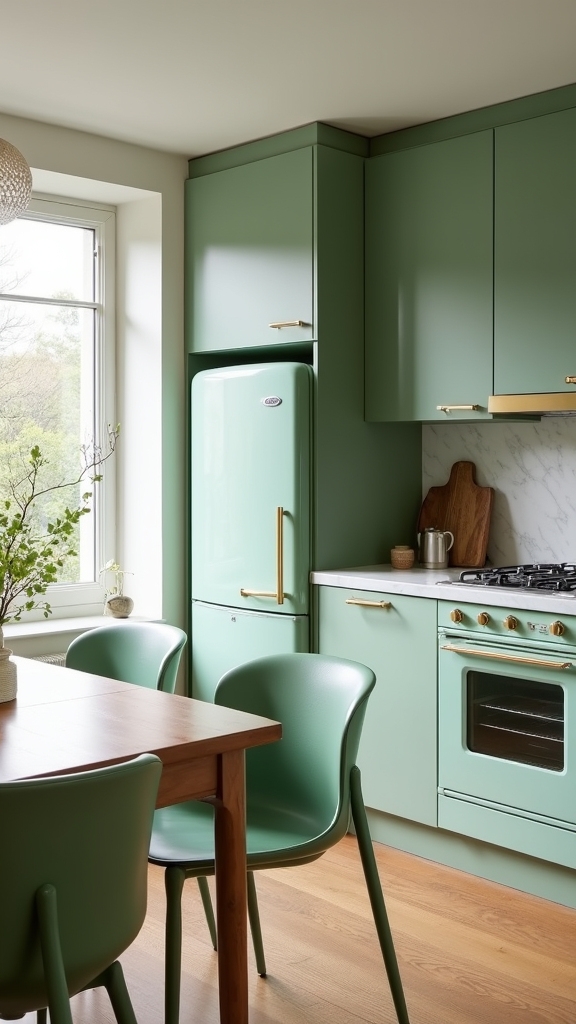
By integrating sage green appliances into the kitchen, designers achieve a seamless extension of the color palette, reinforcing visual cohesion and elevating the overall aesthetic.
Sage green appliances offer a distinctive, modern twist that complements cabinetry, backsplashes, and countertops, establishing a cohesive look grounded in design unity. Their soft, muted tone fosters an atmosphere of calm and harmony, essential for kitchens intended as welcoming and tranquil spaces.
Selecting these appliances allows for creative interplay with both neutral and bolder accents, ensuring the result feels curated rather than overwhelming. Additionally, sage green appliances reflect current trends toward personalized and eco-friendly design, offering not just aesthetic appeal but also functional beauty.
This strategic integration modernizes the kitchen while maintaining timeless elegance and visual balance.
Add Sophistication With Black Accents
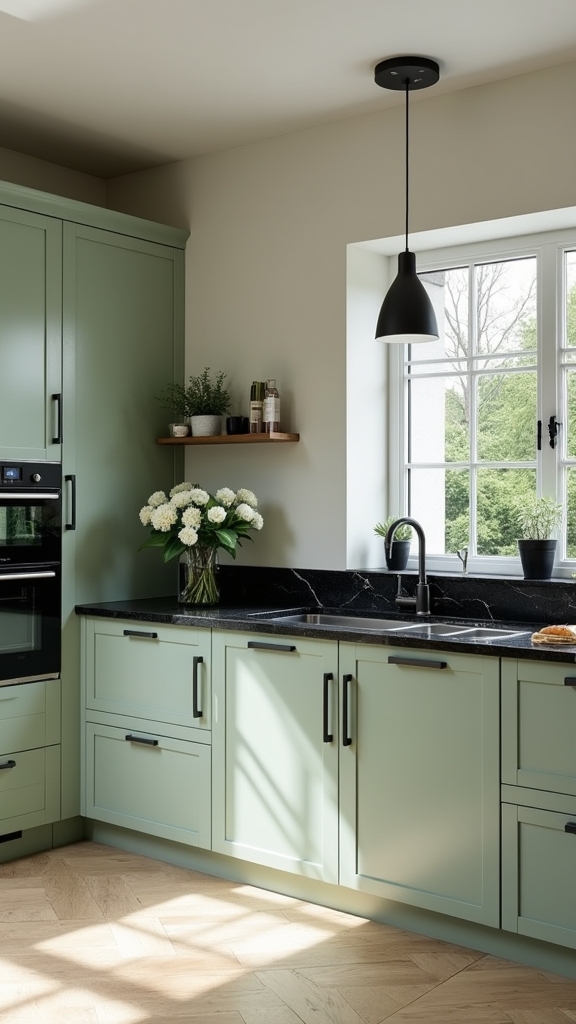
While sage green appliances establish a harmonious foundation, introducing black accents enhances the kitchen’s visual interest through deliberate contrast and refined detail.
Black accents provide a sophisticated counterpoint to sage green cabinetry, anchoring the design and accentuating a balanced color palette. This approach not only raises the modern aesthetic but also guarantees the space remains stylish and timeless.
Black elements such as hardware, fixtures, and appliances inject a graphic quality that draws the eye and creates depth. For a curated effect, consider the following:
- Matte black cabinet pulls and knobs—These add sleek definition to sage green cabinetry.
- Black pendant lighting or sconces—Bold fixtures frame the space and highlight architectural lines.
- Black-framed open shelving or backsplash—Statement pieces that offer both function and visual intrigue.
Gold hardware remains a popular choice in kitchen design, with minimalist aesthetics expected to dominate trends, allowing for a sleek and understated look that complements various styles.
Keep Walls Bare for a Minimalist Look
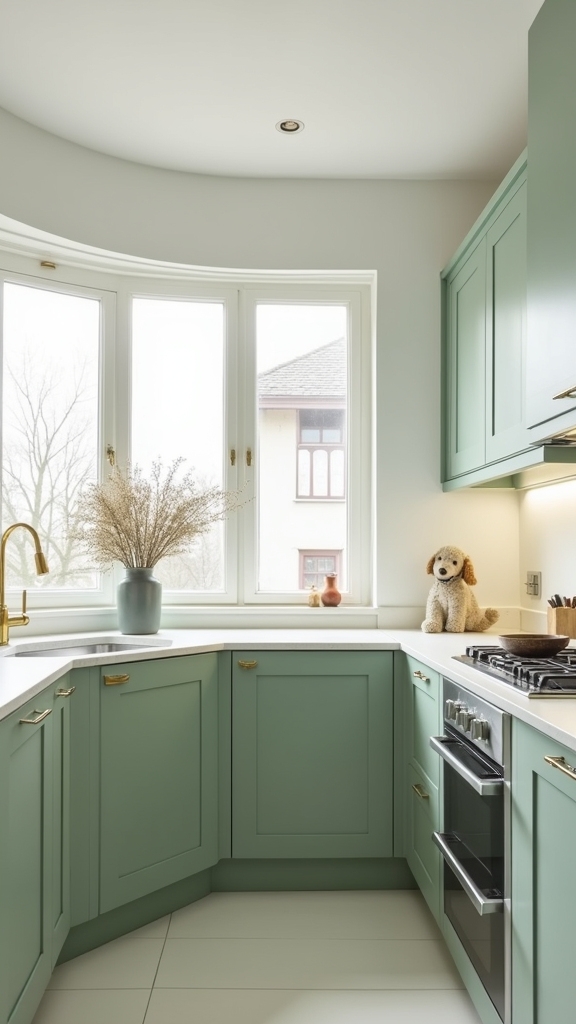
How does one achieve a truly minimalist aesthetic in a sage kitchen? The answer lies in the strategic use of bare walls, which establish a clean visual field and direct attention to the sage green cabinets.
Strategically bare walls set the stage for minimalist kitchens, letting sage green cabinetry take center stage in a tranquil, uncluttered space.
This design tactic exemplifies minimalism by eliminating visual clutter and allowing the cabinetry’s timeless hue to serve as the primary focal point. Bare walls effectively amplify the sense of space, fostering an airy and open environment that feels both modern and inviting.
With unobstructed surfaces, natural light circulates freely, enhancing the reflective qualities of sage green and cultivating a calming atmosphere. This approach harmonizes with sleek countertops and restrained accessories, ensuring design cohesion.
Moreover, a minimalist look facilitates effortless updates, allowing seasonal accents without disrupting visual balance.
Combine Sage Walls With a Patterned Backsplash
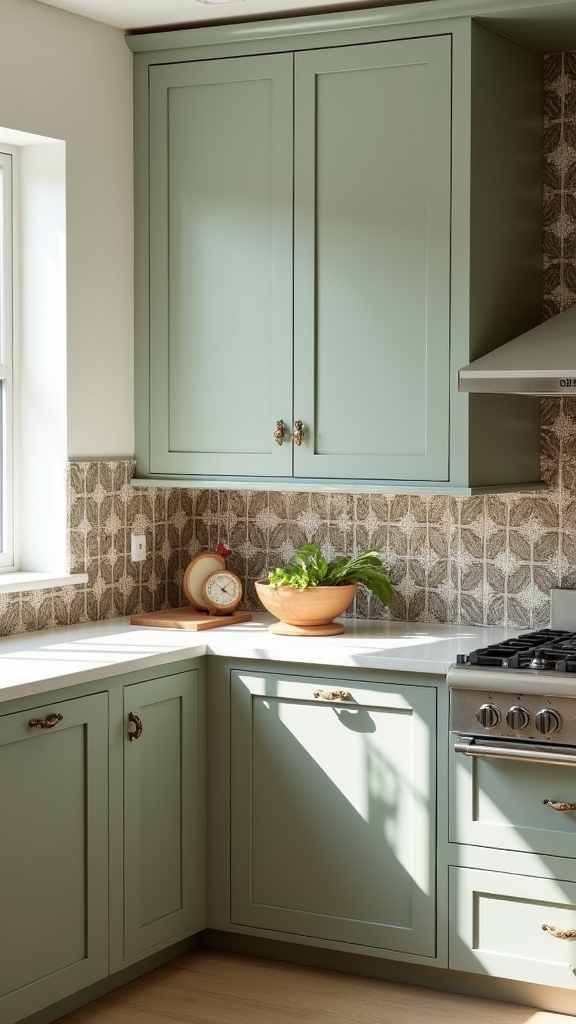
When sage walls serve as the foundational color in a kitchen, introducing a patterned backsplash enhances the visual hierarchy and infuses the space with dynamic interest. This approach leverages subtle color contrast and layered textures to establish a focal point while maintaining a harmonious atmosphere.
Expert kitchen design principles suggest that a well-chosen patterned backsplash can amplify visual interest without overwhelming the tranquil quality of sage walls.
- Select geometric or Moroccan-inspired tiles that incorporate shades of sage to unify the palette and add nuanced personality.
- Opt for finishes—glossy or matte—that interact with light, amplifying the spatial feel and reflective qualities of sage walls.
- Coordinate backsplash undertones, such as warm earth or cool blue, with the sage walls to reinforce cohesion and guarantee a visually balanced kitchen design.
Feature a Light Sage Island Face
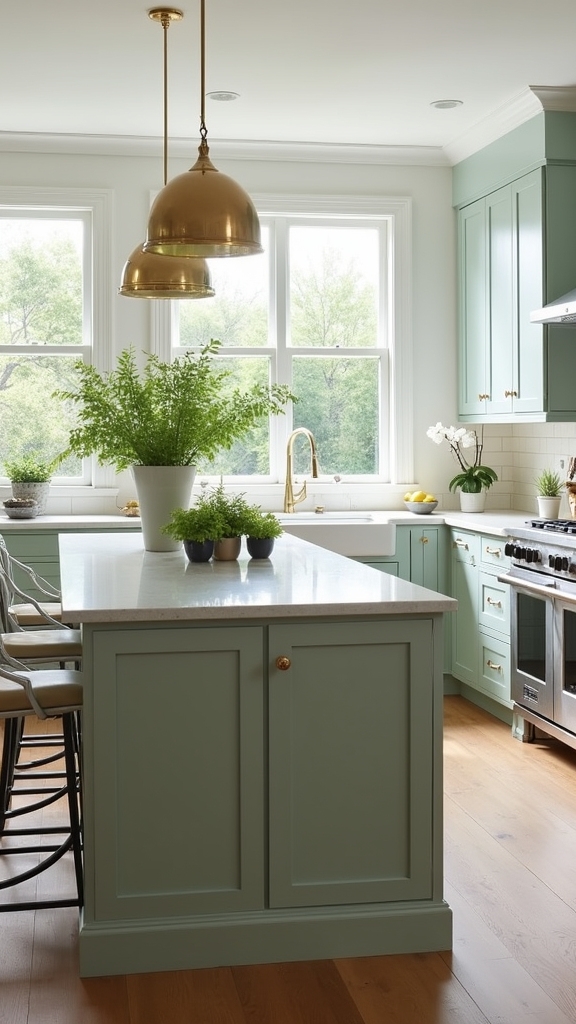
Introducing a light sage island face immediately establishes a fresh focal point within the kitchen, utilizing the hue’s soft undertones to invite a sense of calm sophistication.
Expert application of light sage on the kitchen island’s cabinetry not only enhances visual interest but also bolsters an airy feel, especially when balanced with crisp white countertops and surrounding cabinetry.
The reflective quality of this shade amplifies natural and artificial light, making the space feel open and expansive.
Integrating natural wood accents, such as a butcher block countertop or wooden bar stools, introduces warmth and organic texture, contrasting elegantly with the coolness of light sage.
This versatile approach accommodates evolving design preferences, ensuring the kitchen island remains timeless while adapting seamlessly to seasonal décor and accessory updates.
Brass or matte brass hardware can be used to enhance sophistication and modernity in your kitchen design.
Style Sage Green With Black and White
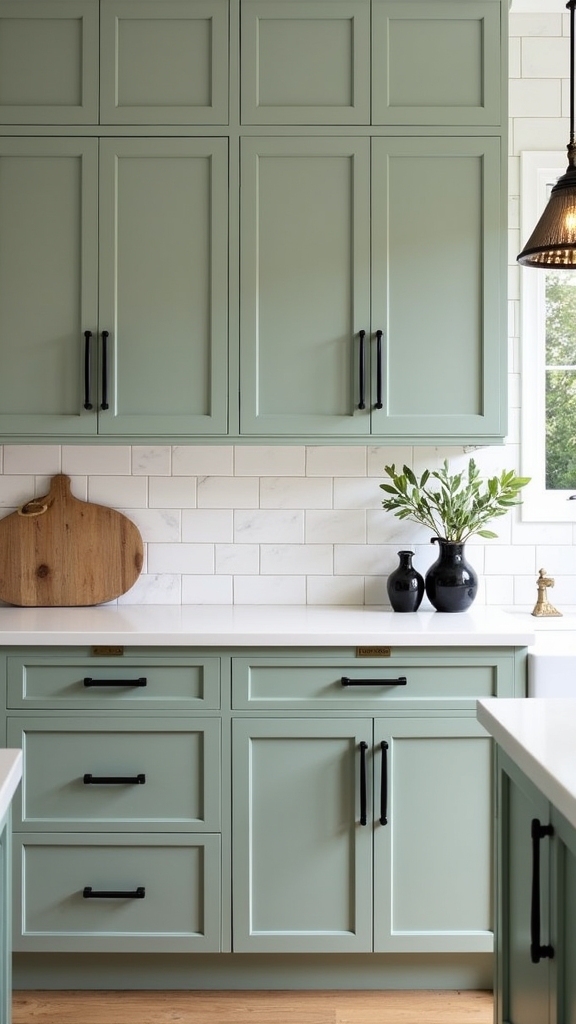
Contrast serves as a foundational principle when styling sage green cabinetry with black and white elements, producing a kitchen environment that is both visually dynamic and harmoniously balanced.
Sage green cabinets act as a serene anchor, while black accents—such as hardware or fixtures—introduce sophistication and depth. White elements provide clarity, ensuring the space remains bright and inviting.
Sage green cabinetry grounds the space, while black brings depth and white lifts the ambiance for a fresh, balanced kitchen design.
The interplay among these tones enhances the kitchen’s visual interest and underscores the timelessness of sage green. Expert designers leverage pattern and finish to create layered, enduring designs. Thoughtful lighting techniques can further accentuate these elements, creating a cohesive and inviting kitchen atmosphere.
- Black hardware and fixtures punctuate sage green cabinets, providing sleek definition.
- White countertops or upper cabinets balance the palette and maintain a sense of spaciousness.
- A black and white patterned backsplash infuses personality and rhythm, harmonizing all elements.
Create Cottage Flair With Light Sage Cabinets
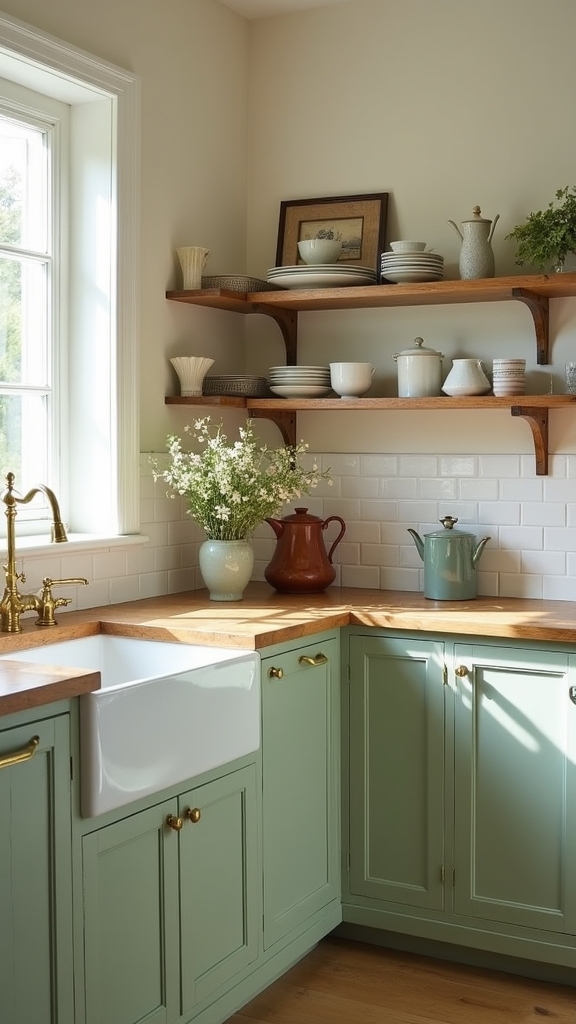
Soft sage cabinetry establishes a quintessential cottage aesthetic by infusing the kitchen with gentle color and understated warmth. Sage green cabinets provide a harmonious backdrop that accentuates cottage flair through their subtle tone and fresh appeal. Pairing these cabinets with white countertops and trim creates a crisp, clean atmosphere, enhancing spatial brightness. Integrating natural elements—such as wooden shelves or rustic barstools—reinforces the connection to nature, a hallmark of cottage design. Vintage-inspired fixtures, like porcelain knobs or antique brass lighting, introduce a whimsical, nostalgic dimension. The adaptability of sage green guarantees it remains a timeless choice, easily refreshed with seasonal accents. The following table illustrates essential design pairings:
| Cabinet Color | Accents | Styling Elements |
|---|---|---|
| Light Sage | White Countertops | Wooden Shelves |
| Sage Green | Brass Hardware | Rustic Barstools |
| Soft Sage | Porcelain Knobs | Vintage-Inspired Fixtures |
| Subtle Green | Neutral Backsplash | Cottage Flair Decor |
Paint Only the Base Cabinets Sage
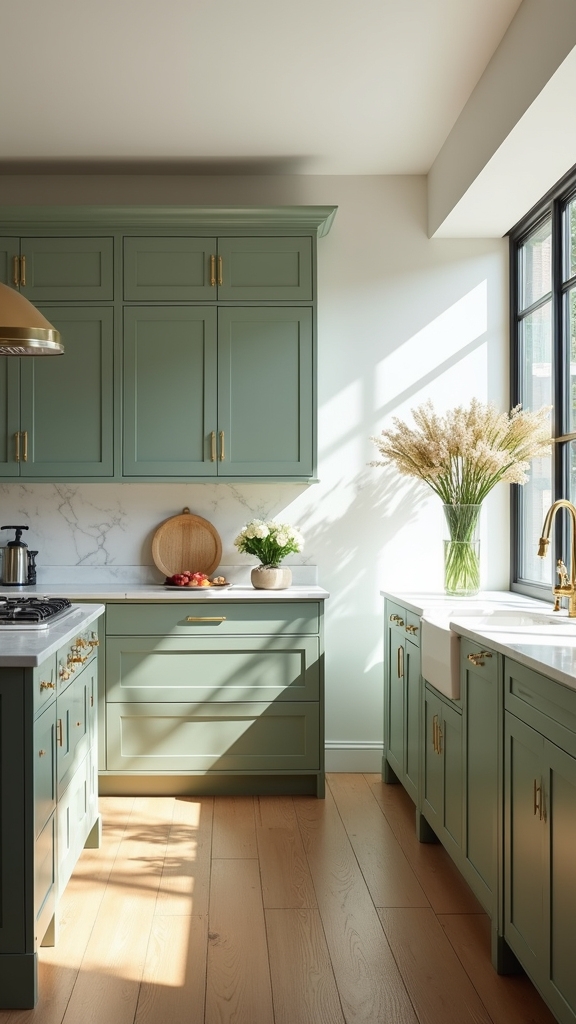
A two-tone kitchen scheme featuring sage green base cabinets and lighter uppers offers a contemporary interpretation of color blocking rooted in classic design principles.
This approach utilizes sage green paint to ground the lower cabinetry, delivering a revitalizing pop of color while the upper units in white or cream maintain a light and airy aesthetic.
The juxtaposition of hues visually expands the kitchen’s vertical space, drawing the eye upward.
Sage green base cabinets also pair effortlessly with natural wood countertops, introducing warmth and organic contrast that enhances the calming atmosphere of the space.
Incorporating greenery and plants can further enhance the freshness and vitality of the kitchen, complementing the sage green tones beautifully.
- Sage green paint on base cabinets creates a visually anchored, serene foundation.
- Light upper cabinets preserve openness and maximize natural light.
- Natural wood countertops coordinate with sage green for a harmonious, timeless palette.
Pair Sage Green Cabinets With Crisp White
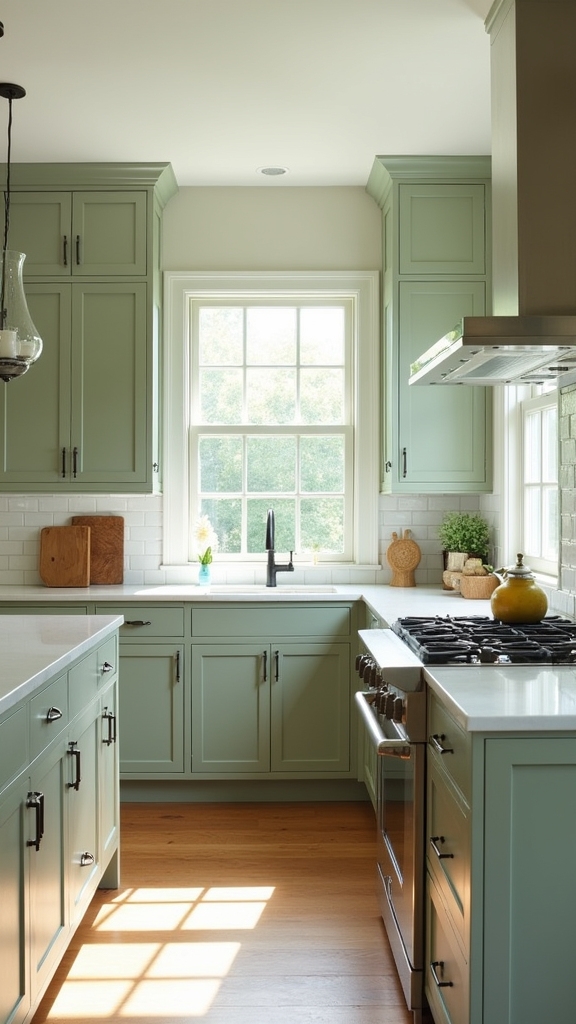
When sage green cabinetry is paired with crisp white elements, the result is a kitchen environment defined by clarity and balanced contrast. This expert-approved color pairing establishes a fresh, clean aesthetic, enhancing the perceived brightness and openness of the space.
Sage green cabinets function as a soothing focal point, while crisp white surfaces—such as countertops, backsplash tiles, or trim—offer a classic, timeless backdrop. The interplay between these hues adds visual interest, preventing monotony and highlighting architectural features.
Incorporating white accessories, including dishware and textiles, further reinforces a cohesive color palette. Versatile across a range of design styles, this approach allows homeowners to achieve enduring appeal and adaptability.
The sage green and crisp white combination remains a sought-after solution for kitchens prioritizing both style and longevity.
Choose a Soft Light Sage Shade
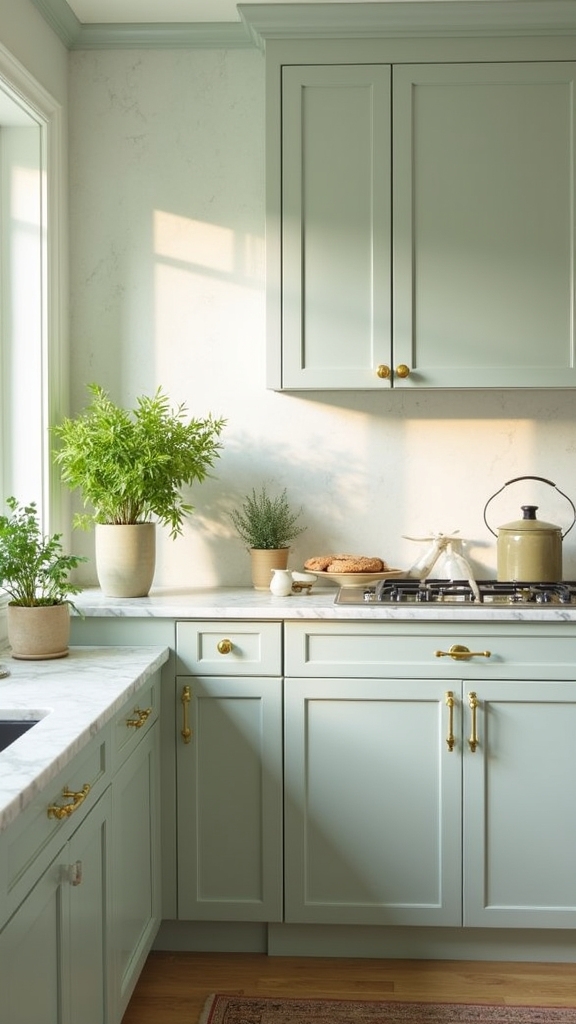
Building on the enduring appeal of sage green paired with crisp white, selecting a soft light sage shade for kitchen cabinetry introduces an understated elegance that promotes serenity and spaciousness. This gentle hue creates an airy, tranquil atmosphere, maximizing the visual openness of the kitchen. The reflective properties of a light sage shade enhance natural light, ideal for spaces with limited sunlight, while the timeless quality of this color guarantees lasting design relevance. Soft sage cabinets integrate seamlessly with both traditional and contemporary aesthetics, offering versatility for evolving decor preferences. Light sage cabinets amplify brightness, visually expanding the kitchen footprint. The soft, muted green complements white surfaces for a cohesive, balanced palette. A timeless soft light sage shade reduces the need for frequent updates, guaranteeing enduring style. Incorporating natural wood elements like walnut can enrich the rustic vibe and add warmth and texture, complementing the sage cabinets beautifully.
Include Natural Elements Like Wood and Stone
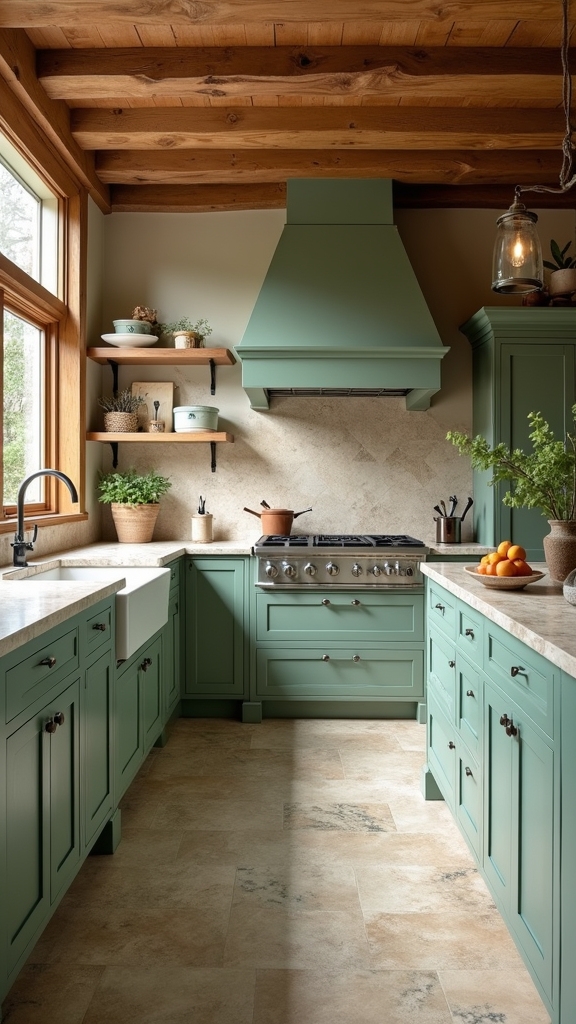
Pairing sage green cabinetry with natural wood introduces visual warmth and a harmonious organic layer, reinforcing biophilic design principles. Stone surfaces, such as marble or granite, serve as striking accents that provide tactile contrast and enhance spatial sophistication. Together, these materials create a balanced interplay of texture and tone, improving both the functionality and aesthetic integrity of the kitchen environment. Incorporating wood panel kitchen island designs with mixed materials and contrasting textures can further elevate the kitchen’s aesthetic, offering both functionality and a dynamic visual appeal.
Pair Sage With Wood
Natural materials enhance the visual impact of sage green cabinetry by introducing organic warmth and texture into the kitchen. The pairing of sage green with wood accents fosters a harmonious, biophilic design, amplifying the kitchen’s inviting ambiance.
Expert designers recommend focusing on materials and finishes that accentuate the natural beauty of both elements. Strategic integration of warm wood tones—ranging from pale oak to deep walnut—balances the subtlety of sage, resulting in a timeless aesthetic.
For a cohesive look, consider the following:
- Butcher block countertops: Offer a functional and tactile surface, complementing sage green cabinetry with rustic charm and visual warmth.
- Reclaimed wood open shelving: Adds texture and personalizes the kitchen while highlighting dishware against a soothing sage backdrop.
- Wooden beams or stools: Infuse architectural interest and reinforce the natural connection, elevating tranquility and design unity.
Accentuate With Stone Surfaces
While sage green cabinetry establishes a tranquil foundation, integrating stone surfaces introduces refined contrast and tactile depth to the kitchen environment.
Designers often specify quartz countertops for their durability and subtle veining, which complements the muted tones of sage green cabinetry. Marble or honed granite deliver sophisticated surfaces that reflect light and enhance the room’s elegance, while stone backsplashes in gentle greys or creamy whites add visual interest without overwhelming the palette.
To balance these cool, sleek materials, natural wood elements—such as open shelving or butcher block countertops—infuse warmth and a rustic note, reinforcing an earthy appeal.
This thoughtful interplay of sage green cabinetry, stone surfaces, and wood accents crafts a harmonious space anchored in organic textures and timeless visual cohesion.
Try a Sage Green Accent Wall
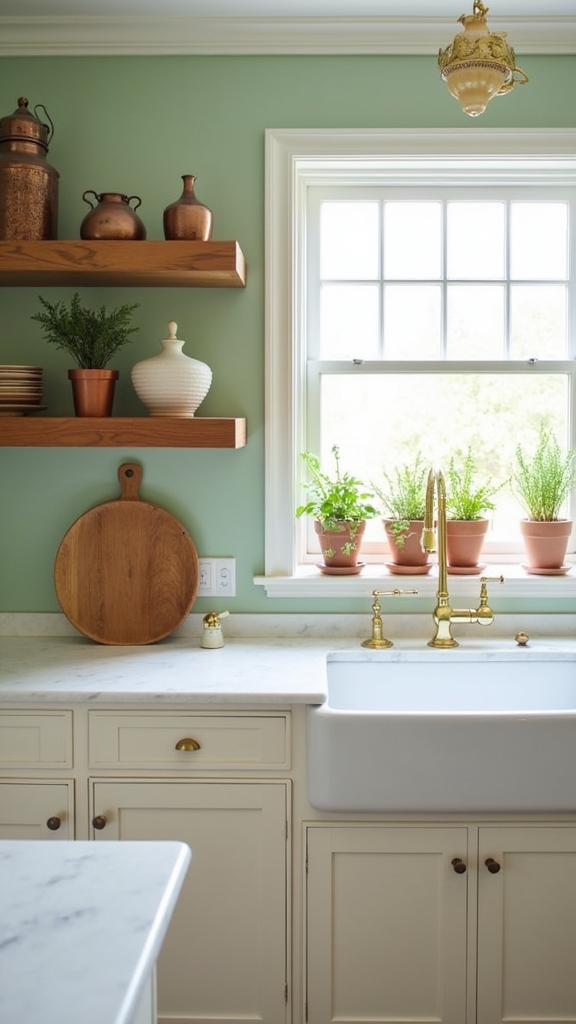
Incorporating a sage green accent wall introduces a refined focal point to the kitchen, elevating the space with a balanced interplay of color and tranquility.
A sage green accent wall brings refined focus and tranquil color to the kitchen, enhancing both warmth and visual harmony.
This expert design move utilizes the soothing undertones of sage to establish an accent wall that not only anchors the room but also reflects natural light, fostering an inviting ambiance.
The timeless quality of a sage green accent guarantees compatibility with evolving trends and personal style shifts, while the versatility of this hue allows for seamless integration with various textures and finishes.
- Strategic Placement: Position the accent wall behind open shelving or the dining nook for maximum visual impact.
- Material Layering: Employ shiplap, matte paint, or botanical-patterned wallpaper to create depth and tactile interest.
- Light Optimization: Pair with white cabinetry to enhance luminescence and maintain a balanced look.
Pair Sage Cabinets With Greige Tones
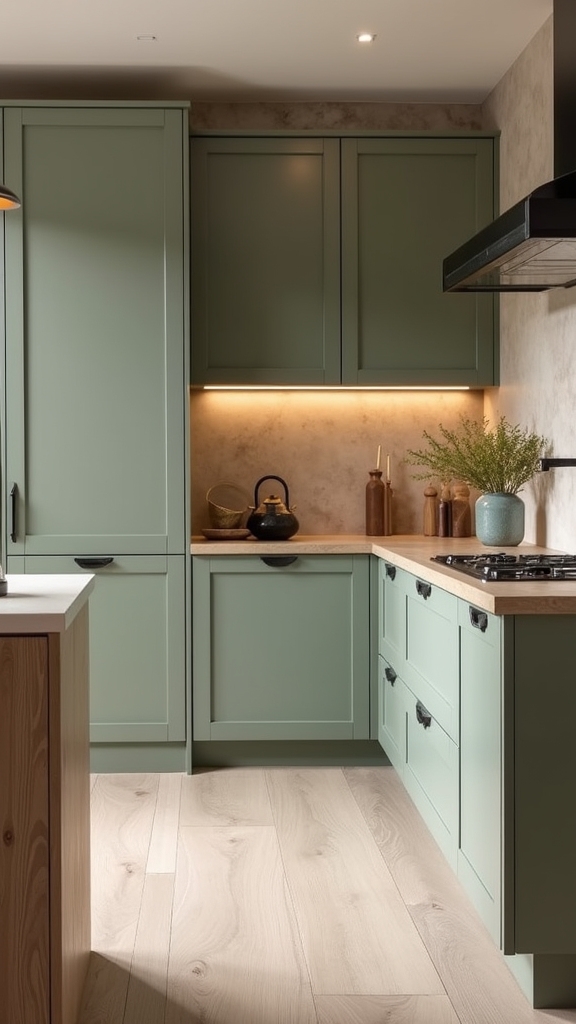
A considered combination of sage green cabinetry with greige tones establishes a balanced and sophisticated kitchen palette that leverages the inherent serenity of green and the understated warmth of gray-beige.
This harmonious pairing achieves a calming ambiance, ideal for both modern and traditional kitchen environments. Utilizing greige tones for countertops, backsplashes, or wall treatments creates a seamless visual connection, allowing sage cabinets to become the focal point without overwhelming the space.
The neutral undertones of greige enhance natural light, further emphasizing the gentle hue of the cabinetry and promoting a cohesive look throughout the interior.
Thoughtful integration of greige accessories, such as dishware or textiles, subtly reinforces the color scheme. This approach exemplifies timeless design principles, ensuring enduring appeal and versatility across evolving kitchen trends.
Highlight Cabinet Doors With Sage Green

Highlighting cabinet doors with sage green introduces a calming chromatic anchor, especially when applied to panel detailing for added depth and dimension.
Contrasting hardware—such as brushed brass or matte black—further enhances the cabinetry, providing both tactile and visual juxtaposition.
This strategic use of color and finish creates a sophisticated focal point while maintaining cohesive balance within the kitchen’s design palette.
Accentuate Panels With Color
Sage green cabinetry introduces a refined yet tranquil focal point by accentuating cabinet panels with color, utilizing this timeless hue to evoke calmness and visual harmony.
Integrating this versatile shade into kitchen design enhances panel details, drawing attention to craftsmanship and form. The color’s soft undertones improve spatial perception, promoting a tranquil environment that seamlessly connects with both modern and classic aesthetics.
This approach supports an immersive design experience, balancing visual weight while maintaining an inviting atmosphere.
- Highlight recessed or shaker-style cabinet panels with sage green to underscore architectural depth and detail.
- Employ a monochromatic palette with varying sage tones to subtly accentuate cabinet panels, reinforcing cohesion throughout the space.
- Pair sage green cabinetry with natural light sources to maximize brightness and create a soothing, open ambiance.
Contrast Hardware and Sage
Many contemporary kitchens achieve visual distinction by juxtaposing the muted elegance of sage green cabinet doors with hardware in bold, contrasting finishes.
Sage green cabinetry gains depth and dimension when paired with contrasting hardware such as brass fixtures or matte black pulls, which punctuate the soft green tones and draw attention to the cabinetry’s refined craftsmanship.
Expert designers often recommend polished nickel or oil-rubbed bronze for those seeking a sophisticated look that bridges both modern and traditional sensibilities.
Mixing hardware types—like combining sleek pulls with classic knobs in different finishes—introduces visual rhythm and a personal touch while enhancing the cabinetry’s timeless charm.
This strategic interplay of color and finish enhances the overall kitchen design, ensuring sage green cabinetry remains a striking focal point.
Add Leather Stools for Warmth
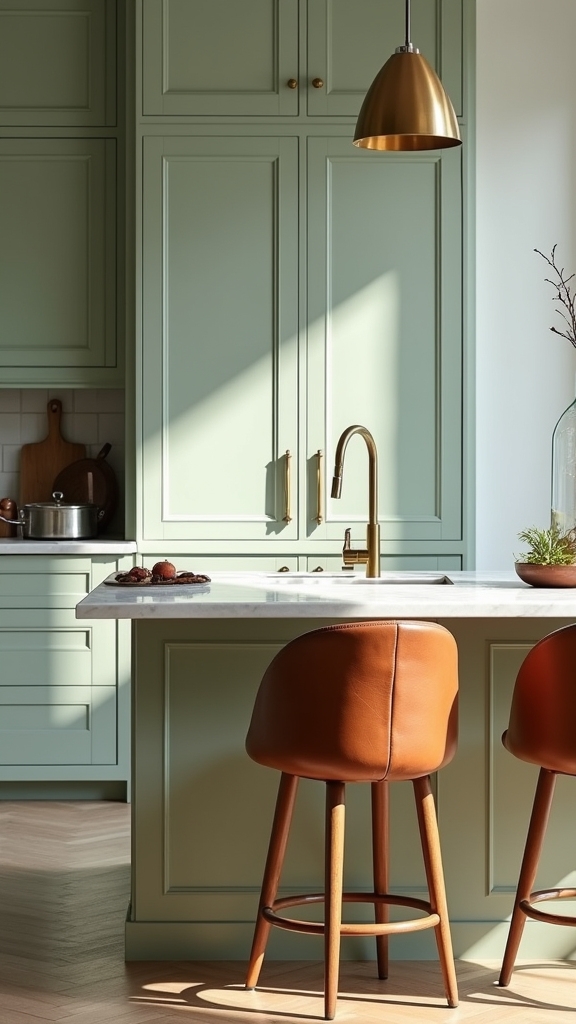
When integrating leather stools into a kitchen with sage green cabinetry, the material’s inherent warmth and tactile quality serve to balance the cool undertones of the cabinetry. Leather stools introduce a layer of sophistication, enriching the ambiance with both visual depth and a sense of comfort. Their versatility allows seamless alignment with modern or traditional design, reinforcing the kitchen’s stylish and timeless appeal. Selecting leather stools with nuanced textures and complementary tones further enhances cohesion. For a visually engaging and harmonious kitchen layout, consider:
- Rich caramel or espresso leather stools to contrast and highlight the calming effect of sage green cabinetry.
- Sleek silhouettes combined with subtle brass or metal accents for a polished, enduring aesthetic.
- Durable leather surfaces that maintain warmth and withstand daily use, ensuring long-term functionality and elegance.
For an added touch, consider incorporating decorative kitchen towel placement on oven handles or cabinet knobs to combine style with accessibility.
Complement Sage Green With Gold Fixtures
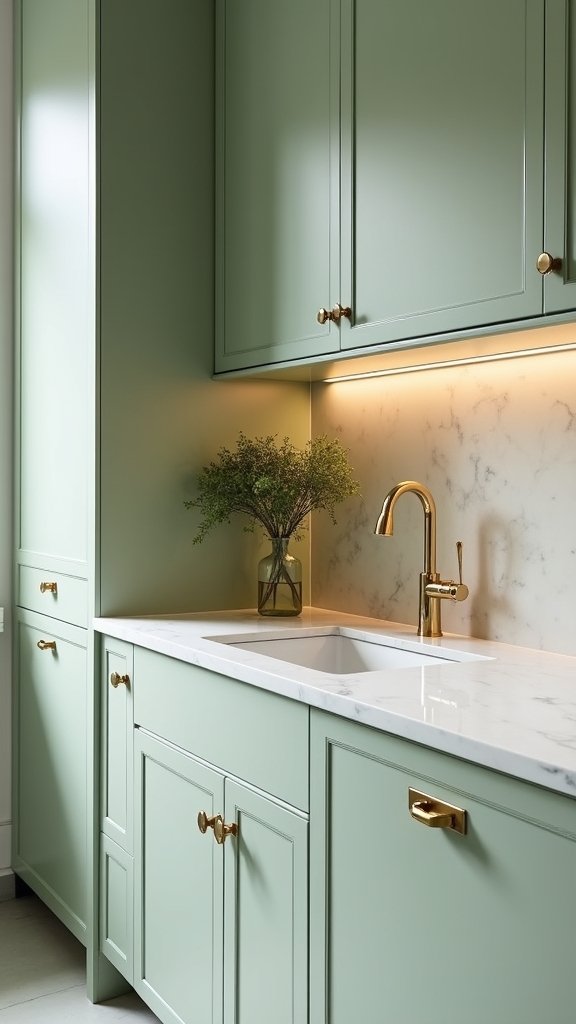
Pairing sage green cabinetry with gold fixtures introduces a strategic use of metallic accents to enhance the overall palette.
The interplay of warm gold tones against the cool, muted green achieves an ideal balance of warmth and luxury while bridging modern and classic design sensibilities.
Utilizing matte or brushed gold finishes further refines the aesthetic, ensuring cohesion and sophistication within the kitchen space.
Elevate With Metallic Accents
Although sage green cabinetry exudes tranquility and subtle sophistication, integrating gold fixtures introduces a layer of luxury that amplifies the overall aesthetic.
The juxtaposition of sage green with metallic accents, particularly gold, creates a refined harmony that enhances both visual appeal and timeless decor. Expert designers utilize gold fixtures not only for their elegance but also for their ability to create focal points within the kitchen.
Thoughtful application of metallic accents guarantees the space feels curated and cohesive rather than overwhelming.
- Gold drawer pulls and cabinet knobs add a striking contrast against sage green cabinetry, providing tactile interest and shimmer.
- Brass or gold pendant lighting above kitchen islands offers both functional illumination and cohesive design, reinforcing a sophisticated palette.
- Decorative gold accessories, such as trays or picture frames, unify the space and accentuate the cabinetry’s tranquil tone.
Warmth and Luxury Combined
Luxury manifests in the subtle interplay between sage green cabinetry and gold fixtures, where color theory and material selection converge to create a balanced, inviting environment.
The cool undertones of sage green cabinetry are enhanced by the reflective, warm finish of gold hardware, producing a sophisticated contrast that underscores timeless appeal. Designers often specify gold hardware—such as knobs, pulls, and faucets—to enrich the organic qualities of sage green, fostering both visual cohesion and warmth.
This deliberate pairing not only amplifies tactile richness but also guarantees the kitchen remains welcoming and chic. Integrating gold accents through light fixtures and open shelving brackets further reinforces the luxurious atmosphere, aligning with contemporary trends that favor bold yet harmonious color and material combinations for enduring, elegant kitchen spaces.
Balancing Modern and Classic
Building on the synergy between sage green cabinetry and gold accents, the interplay of these elements serves as a prime example of how modern sensibilities can be harmonized with classic design.
Sage green kitchen cabinets evoke a calming, earthy palette, while gold fixtures introduce a refined, luminous edge. This combination seamlessly bridges modern minimalist aesthetics with classic charm, establishing a timeless look that adapts to evolving trends.
The integration of gold hardware, from sleek pulls to sculptural faucets, enhances the visual hierarchy and adds depth to the cabinetry. Designers recommend layering metallics strategically within the kitchen for enduring appeal.
- Gold pendant lighting above sage green kitchen cabinets for ambient sophistication
- Brushed gold drawer pulls and knobs for understated elegance
- Gold-bracketed open shelving to unify function and luxury
Tile the Walls in Sage Green
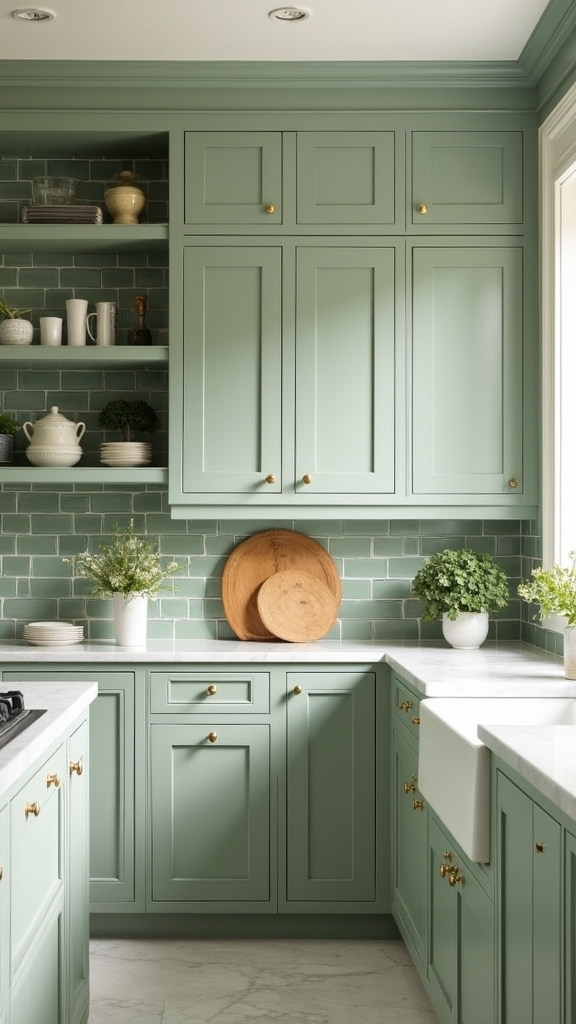
A well-chosen arrangement of sage green wall tiles introduces a cohesive and tranquil backdrop to kitchen spaces, establishing visual continuity between cabinetry and surrounding elements.
Employing sage green tiles as a backsplash not only strengthens a cohesive atmosphere but also enhances visual interest through nuanced texture—whether with classic subway tiles or handcrafted zellige styles.
The application of this versatile color supports harmonious integration with diverse countertop materials, including white quartz and natural stone, ensuring a seamless and sophisticated palette.
Strategically placed sage green wall tiles can emphasize focal points such as open shelving or sinks, drawing the eye while maintaining design unity.
Additionally, the reflective qualities of glazed sage green tiles amplify available light, imparting a fresh, inviting ambiance without overpowering the overall kitchen aesthetic.
Frequently Asked Questions
Are Sage Green Cabinets Timeless?
Sage green cabinets exemplify timeless design elements, balancing enduring sage green trends, versatile cabinet material choices, and harmonious sage green pairings. Kitchen color psychology highlights their calming effect, while adaptable shades guarantee longevity within both contemporary and classic interiors.
What Is the Most Timeless Kitchen Cabinet Color?
When evaluating the most timeless kitchen cabinet color, design experts highlight sage green for its adaptability in kitchen design, positive color psychology, compatibility with diverse cabinet finishes, and enduring appeal across evolving interior trends and visual aesthetics.
What Color Kitchen Cabinet Never Goes Out of Style?
When considering what color kitchen cabinet never goes out of style, experts emphasize neutral color palettes paired with classic cabinetry designs. These elements transcend popular kitchen trends, accommodating vintage hardware styles and contemporary finishes, ensuring lasting visual harmony and adaptability.
Which Kitchen Style Is Timeless?
A timeless kitchen style integrates classic elegance with minimalist design, often showcased in modern farmhouse aesthetics. Incorporating open shelving and vintage accents, this approach balances visual harmony, enduring appeal, and functional sophistication, ensuring longevity regardless of shifting design trends.
Conclusion
Sage kitchen cabinets offer a refined balance of tranquility and sophistication, seamlessly integrating with diverse materials and finishes. By utilizing contrast—such as pairing with wood, gold, or black accents—designers achieve depth and visual interest. Thoughtful integration, whether through focal cabinetry, appliance coordination, or complementary seating, guarantees timeless appeal. Embracing sage as a central palette or accent enhances both modern and classic kitchens, underscoring the enduring power of color harmony and material interplay in kitchen design.
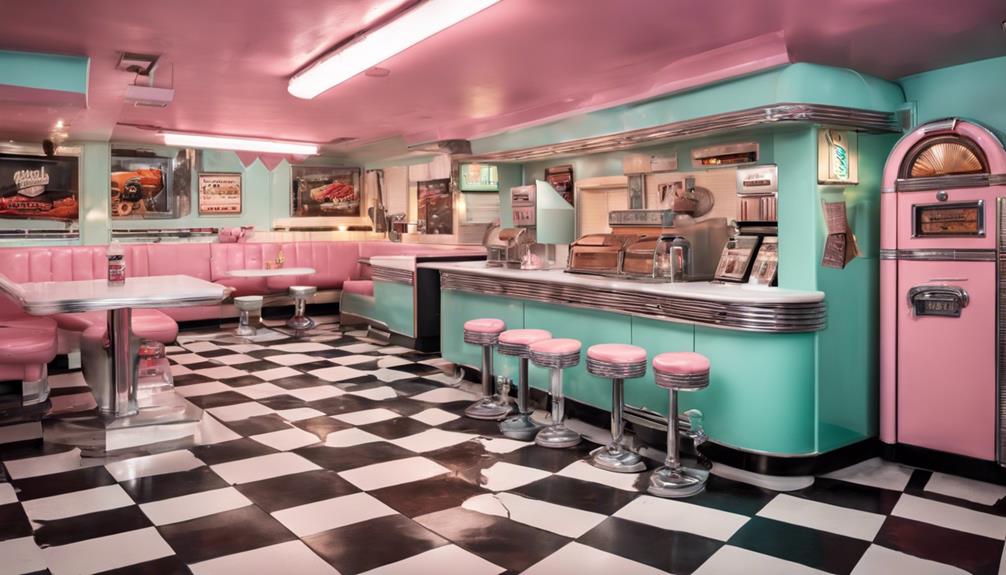
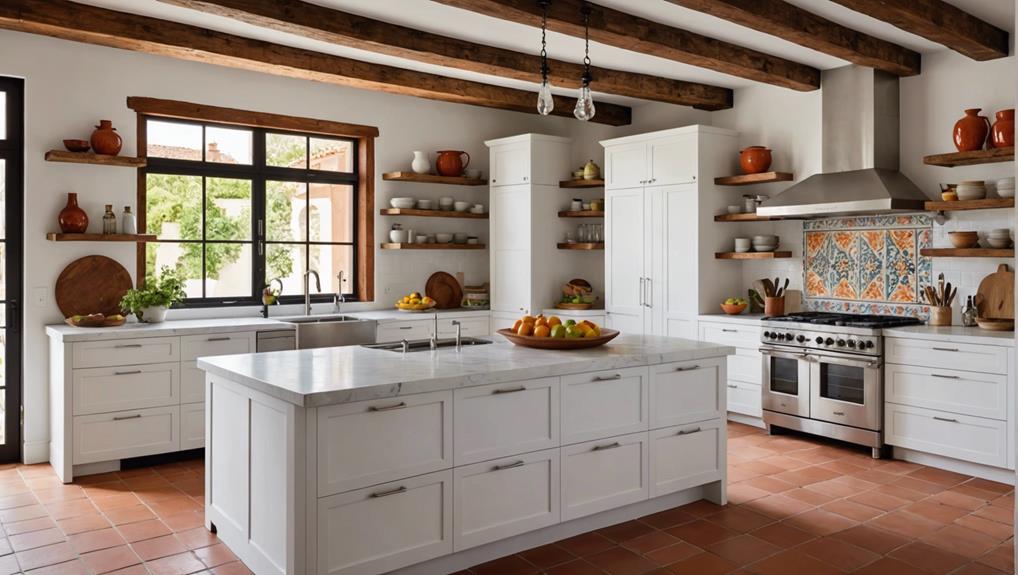
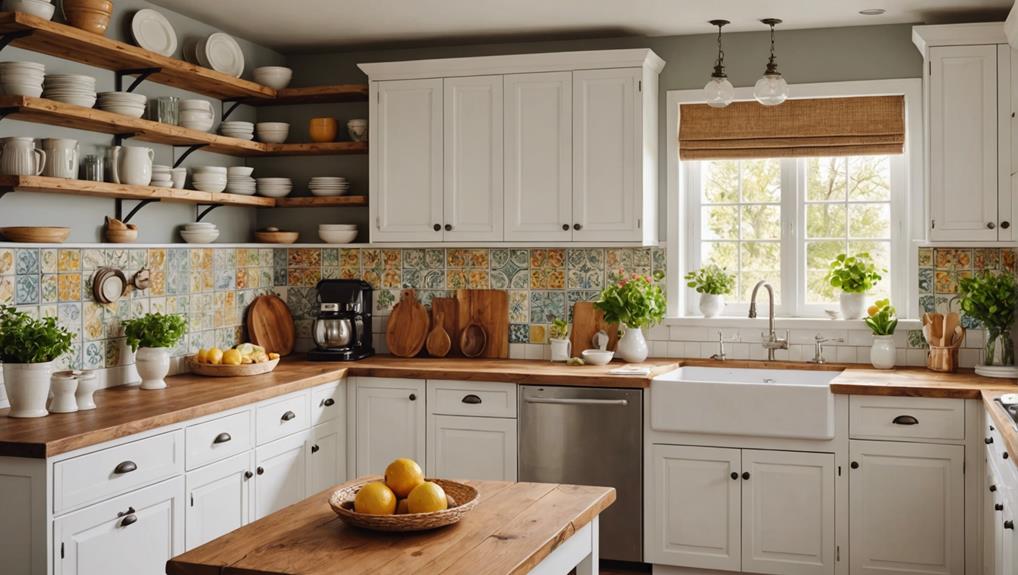
Leave a Reply